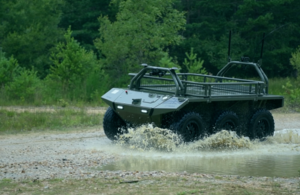Dstl showcases autonomous future for army logistics
Uncrewed ground vehicles are being trialled for potential use in future resupply operations.

The potential future of the British Army’s logistic capabilities has been showcased by the Defence Science and Technology Laboratory (Dstl) at the Combat Service Support Training and Development Unit (CSS TDU) in Aldershot.
Dstl has been scientifically assessing the potential use of autonomous systems for resupply operations to provide greater capability and utility for the Army under the Joint Tactical Autonomous Resupply and Replenishment (JTARR) project.
This work will inform the wider Project Theseus, which aims to ‘define and deliver an end-to-end, highly automated ground and air resupply network, enabled by a logistic information system; 24/7 and in all conditions.’
Two uncrewed ground vehicle (UGV) systems from HORIBA MIRA and QinetiQ were purchased by Dstl in March 2020 under contracts collectively valued at £5 million.
HORIBA MIRA’s Viking is a 6-wheeled tracked vehicle capable of operating at 50 kilometres per hour (kph) even in electric mode. The vehicle uses advanced AI-based autonomy, based on visual terrain recognition, to enable GPS-denied navigation, terrain perception and object recognition. It can carry up to 600kg of supplies.
QinetiQ’s Titan UGV comprises a tracked system based around a modular mission system software architecture, employing LIDAR (a remote sensing technology using lasers) and stereo vision as the primary means to detect its environment. The vehicle is powered by a hybrid electric engine with a lead acid battery and has a top speed of 20kph with a load capacity of up to 750kg.
The Dstl trials will fully test the machines’ capabilities to increase the understanding of the potential of UGV systems and understand how they will integrate with the wider defence logistics capability.
Dstl Principal Technical Authority, Guy Powell, said:
During the trials we are conducting we are assessing mobility, to understand if they can get to the dismounted soldiers; autonomy – how well they navigate; and to understand the limitations of the technology.
Equipment support Sergeant Major Dan Brown added:
If there is a machine that can do what a human can but take personnel from harm’s way, that’s a fantastic thing. If robots can take over certain tasks, soldiers can do other, more vital ones.
The concept of resupply is critical. Troops can’t fight without water, food or ammunition. And these platforms are very good. It is absolutely realistic to deploy them in the near future.
The JTARR project is a scientific assessment of the robotics and autonomous systems (RAS) technologies, capabilities and limitations through the purchase and trials of selected systems developed during the Autonomous Last Mile Resupply (ALMRS) project initiated in 2019.
The Future Capabilities Group (FCG) Theseus competition, led by the Expeditionary Robotics Centre of Expertise (ERCOE), aims to more broadly assess the current marketplace, completing experimentation activity with Army personnel. This experimentation will develop the user requirements and tactical viability of use of a RAS system of systems for logistical resupply activity through user interaction, which will build upon, and be informed by, the outputs of this prior activity from the Dstl JTARR project.
Both projects are funded from the Theseus transformation fund, but the Dstl project is referred to as JTARR to differentiate it from the FCG Theseus competition.